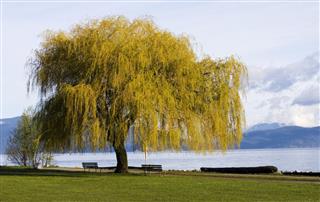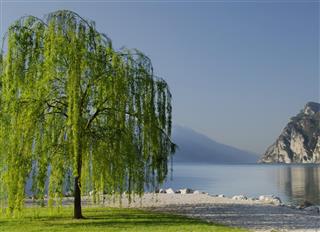
Weeping willow tree diseases may be of many types and if left untreated, they might rip this elegant tree off its beauty. Know about these diseases and how to manage them.
Mostly found in the Northern hemisphere, the weeping willow tree is among the most popular deciduous tree types which people choose to add to the beauty of their landscape. Scientifically known as the Salix Babylinoca, the weeping willow tree is one of the fast growing shade trees. It can attain a height of about 10 ft in just about a year with proper care and maintenance.
Ponds, streams and lakes are the common areas where the Weeping Willow tree mostly grows. It can also adapt to different types of soil. It is drought-tolerant to some extent, and prefers moist and cool conditions.
A weeping willow tree is characterized by its rounded, drooping branches which are again accompanied by lush green foliage and long, thin leaves. Depending upon the type of the tree, the leaves wear colors of light yellow-green shade to an eye-catching blue color, in the fall. Fall is the time when the trees shed their leaves and during summers, the weeping willow is ideal for its use as a shade.
Diseases that Commonly Affect the Weeping Willow Tree
# A weeping willow tree is mostly affected by root rot which has its ill effects on the roots of the tree and eventually leads to its decline. This disease is often a result of over-watering. Excess watering deprives the roots of air required for the plant’s survival thus, causing them to decay and eventually death of the plant.
# Willow trees are also vulnerable to develop crown gall, a bacterial disease of plants (especially of pome, stone fruits, grapes and roses which forms excrescences on the stem near the ground). It is responsible to form galls near the soil line, and farther up the plant. Galls are abnormal swelling of plant tissue caused by insects, microorganisms or injury. This disease may also cause the tree to contract secondary diseases that attack the tree through the decaying galls.
# Weeping willow fungus diseases known as scabs attack the freshly sprouted leaves and cause the formation of blackish or reddish-brown blotches which infect the leaf stocks and cause them to wither and fall off. If left untreated, the scabs can infect the twigs and branches of the tree. You may also notice black cankers (caused by a fungus Physalospora miyabeana) in the form of grayish or pale brown depressions. Whitish gray lesions with black borders appear on the twigs and stems. A combination of black canker and willow scab is known as willow blight. Due to these two tree diseases, defoliation occurs year after year, and eventually the tree dies.
# Many types of fungi cause leaf spots, and the powdery mildew gives the appearance of a white coating on the leaves of the Weeping Willow. At times yellow spots can also be detected on the lower sides of the leaves, which are caused due to rust. In severe cases, defoliation is common. The leaves may also carry harmless black, raised spots known as tar spot.
How To Care for a Weeping Willow Tree
# For countering crown gall, you should get rid of the infected plants, and do not replant in the same area until after two years.
# For countering willow scabs and black canker in Weeping Willow trees, prune out infected branches and use resistant species.
# Regular fertilization and raking up the fallen diseased leaves are essential to keep away all kinds of fungi from affecting the Weeping Willow.
# Common weeping willow pests are the gypsy moth, caterpillars, scales, aphids, and borers. In order to get rid of such pests, you can go for insecticides or natural weeping willow pest control. Before deciding on any such pest control, seek proper advice from the dealer or someone who is well acquainted in this field.
# Planting your weeping willow tree in loose, healthy soil is important. Before placing the tree, ensure that the hole which you dig in is twice the size of the root ball. After placing the tree do not leave the roots exposed; cover them well with soil. Thereafter, using a sprinkler or a hose allow the tree to soak well in water. Take a note that the plantation of the tree must be done about six weeks before the first frost of the season, to allow the tree to get adjusted to its new environment.
# In places where there is extreme heat, the potted weeping willow tree must be placed in a well-shaded area. As it grows older it will start getting used to such a temperature. In the summer months, the tree must receive water during extended dry spells. If the leaves are drooping then it may indicate under or over-watering. So, keep a check on the watering. Crisp, healthy looking leaves show that the tree is receiving adequate amount of water.
# In the first year, keep weeds and grass away from the tree and keep the use of fertilizer to a small amount. Prune a matured weeping willow tree regularly, as it helps in the healthy growth of the tree the following year.
Good soil, proper feeding and adequate watering keeps the Weeping Willow healthy, and helps it to maintain its prosperity. If all these factors are well looked after, then you should not be concerned, even if your tree looks dead in the winter months. In the fall, the tree would shed its leaves and the trunk will turn brown, indicating that the tree is going into a dormant state. It’s a natural process which all deciduous trees go through.
Keep a close eye on the common diseases that could affect your tree, and wait for the spring when you can enjoy seeing it flourishing with health and beauty.

